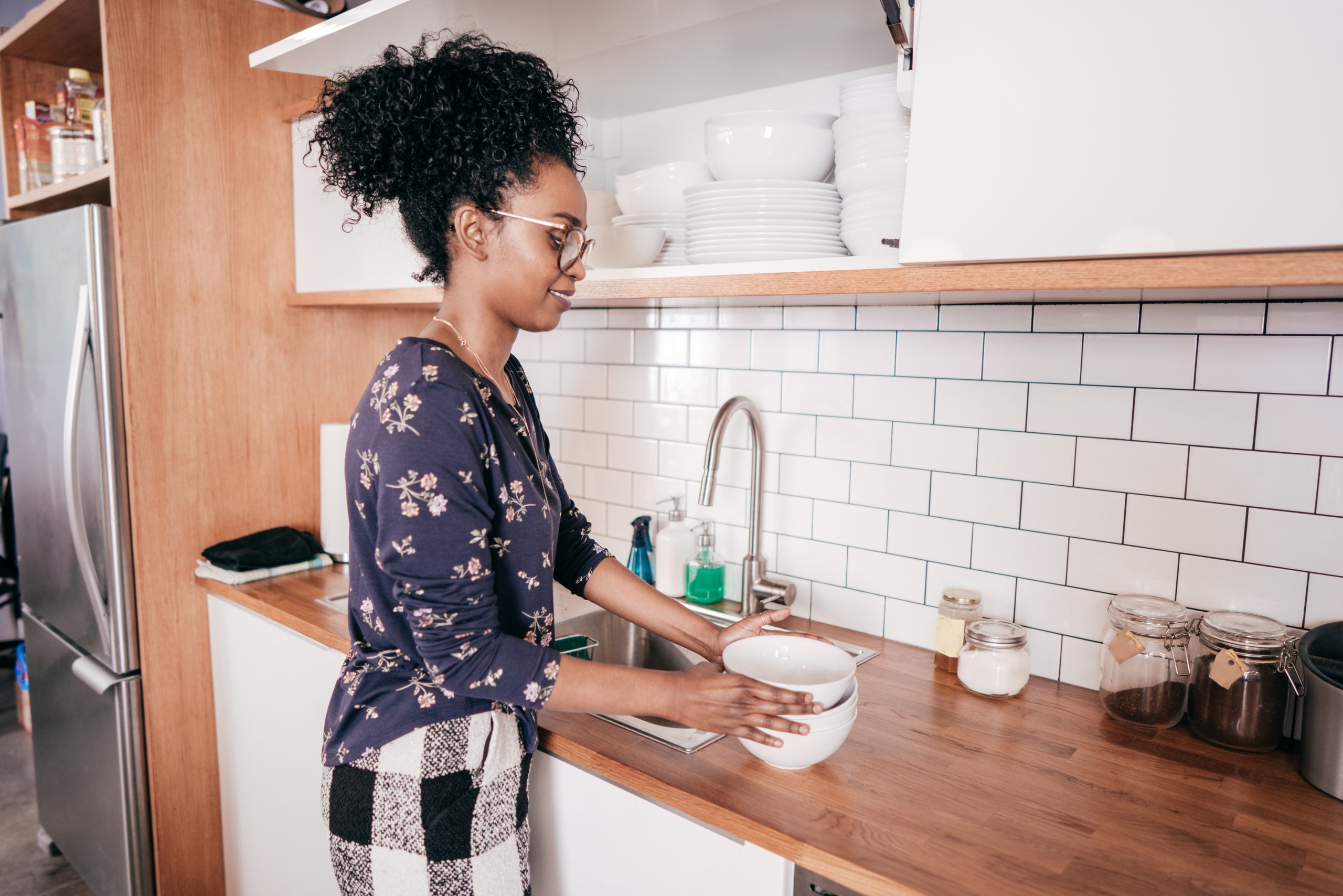Clear countertops make our hearts sing, but kitchen organization is so much deeper than that.
In the grand scheme of life, shiny countertops may seem like a superficial concern, but anyone with a kitchen knows that they’re actually a very unavoidable reflection of what kind of day, week, or month we’re having. An expanse of decluttered, polished quartz is a clear indicator that we’re energetic, motivated, running on schedule, and just generally killing it in life. Cluttered, crumb-dusted, sticky countertops punctuated by empty coffee mugs and little piles of mail tell an entirely different story.
The power of kitchen organization doesn’t end at the countertops, either: When your kitchen is even a little dysfunctional, that can easily carry over to other areas of your life, from your morning routine to what you eat—and thus how you feel—to how much quality time you spend with your partner or family in the evening. If you don’t make your bed or fold your sweaters for a few days (or years), your life won’t fall apart; if you stop putting away dishes or taking stock of your pantry, it actually kind of will.
That said, kitchen organization can also be far more intimidating than, say, revamping a closet or your garage shelves. For starters, you’re dealing with a truly finite amount of space. You want to keep many items within close reach, but you have to work with the cabinet space and kitchen drawers that you have. (Unlike in other rooms, where you can usually squeeze a few storage bins somewhere, it can be trickier here to carve out additional storage space—especially if you have a small kitchen.) Plus, you’re dealing with a massive quantity of daily-use items that need to be easy-access but that also have very specific storage needs: delicate glassware, bulky gadgets, heavy cookware, clanky baking sheets, bulky cutting boards, and an always unruly hodgepodge of cooking utensils and silverware.
With all of this in mind—and in the interest of starting the new year off in the most sane way possible—we asked some of our favorite professional organizers to serve up some of their best kitchen-organization ideas and hacks. Start file-folding those dishtowels and sorting through that junk drawer, because your transformative kitchen-organization makeover starts now.
Block your kitchen into zones.
First things first: Pause and really think about what raw features your kitchen has and what you need to get out of it. Do you currently have things set up to flow logically and easily, or might there be a better big-picture way to use the space? Are your dishes and pots and tools stowed near the area where you’ll use them? “When it comes to kitchen organization, you really want to think about the items you have, the space each item would best fit in, and where in the kitchen you use it,” says professional organizer Corinne Monahan of Grid & Glam. “It helps to think about your kitchen in terms of zones. For example, you may have an everyday dishware zone, a baking zone, a cooking zone, and a dry food/pantry zone. Set up a system that works for you and your lifestyle.”
Stow away the non-everyday.
Another good starting point for rethinking your kitchen organization: Introduce a backup storage system for items you don’t use for your weekly meal prep, if you don’t already have one. “We often recommend our clients designate an area where they can store less frequently used kitchen items,” says professional organizer Jordan Marks of It’s Organized. “For example, holiday-specific items should be binned with decorations and only brought out for that season. This will free up space in your kitchen cabinets and drawers for items you use all the time.” If you know you use your Cuisinart only before hosting Thanksgiving, there’s no reason it should occupy prime real estate under your kitchen island; let it hide out in your basement storage closet instead. Likewise for that giant paella pan you use maybe twice a year.
Find hidden storage.
Unless you’re a true minimalist—or even never cook—you probably could use some extra kitchen storage space. Luckily, you have plenty of options. For example, consider whether you have room to add a utility cart, a rolling butcher block, or a movable kitchen island—this one even features its own pot rack—which will give you prime prep space and storage space. Look to your walls too: You can likely find a good spot to squeeze in a pegboard, perfect for putting pans and cooking tools within reach (and cute to look at too). An over-the-door organizer is an even easier way to capitalize on vertical space in the kitchen; one with clear pockets works perfectly as a hanging spice rack on a pantry door. Introducing smaller custom storage solutions within your existing cabinets and drawers can be just as big a game changer—things like drawer dividers for cutlery and adjustable drawer organizers to neatly sort food-prep tools, a few lazy Susans to corral bottles of vinegar and the like (so you’re not knocking them over looking for ingredients mid-stir-fry), and a knife block to clear up drawer space and keep knives sharp (and your hands safe). To make better use of ample room under your kitchen sink, add a caddy (or three) for cleaning supplies, so you can just grab the whole thing and not topple 67 bottles. You can also install pull-out shelving designed specifically to smarten up this clutter-prone zone.
Control clutter.
Speaking of which: Decluttering your kitchen really can feel like the chore that never ends. Before you’ve found homes for all those stray receipts, cookbooks, and bills, incoming pieces of mail and outerwear have taken over the island. Yet decluttering is key to keeping this room sane. “The kitchen is the hub of the home, the central gathering area for socializing and eating as well as food prep, so keeping it clutter-free can be extra challenging,” says professional organizer Dorothy Breininger, a.k.a. Dorothy the Organizer. Her favorite hacks for clutter-prone zones include designating a “drop zone” on countertops that’s separate from your food-prep counter space, i.e., no homework or shopping bags allowed on the island, just the corner desk area. Then have a set time of day when you clear that drop zone area and return items to their homes (or the recycling bin).
Get your cabinets in shape.
When it comes to cabinet organization, focus on rearranging things according to how often you use them; daily-use items should be easy to grab and within reach, while infrequently used items can go high up and way to the back (or, ideally, to your backup storage area, as mentioned above).
Uncomplicate meal prep.
You may like to view it as “European,” but running to the grocery store every single day isn’t necessarily efficient—if you’re not shopping thoughtfully, you can easily end up impulse-buying things you don’t really need (or want to be eating), duplicating foods you already have, and not using up items already in your fridge. As daunting as the term can sound, meal planning doesn’t have to be a super-complicated process. One simple and fun way to start, especially if you have a family: Work out a rotating theme menu—Meatless Mondays, Taco Tuesdays, Pasta Wednesdays, etc. “That way, the wheel doesn’t have to be reinvented every single night, but it doesn’t have to be boring either,” says professional organizer Kate Pawlowski of Done + Done Home. “It could be fish tacos one week, chicken the next, and a taco pizza the third. Food prep will be easier because the menu will be set and time spent coming up with meal ideas will be minimal.” You’ll cut down on shopping time since many ingredients will repeat one week to the next, meaning you’ll know how much to buy and where they are in the store, and you can even hit up a bulk store to stock up on frequently used items—beans, rice, pasta, frozen meatless meatballs—to trim your weekly shopping list. Bonus fridge-decluttering tactic: Brainstorm a few easy lunches that use leftovers from the meals in your rotation. As for the process of meal planning, focus on what feels easiest to you. “I’m a paper girl and need to write down our family’s meal plan on a pad each week, but there are also great apps and online options as well,” says professional organizer Rachel Rosenthal of Rachel & Co. (One app professional organizers recommend: Paprika.) “And remember that easy dinners and dining out count within meal planning too. It is easy to hear ‘meal planning’ and envision picture-perfect, made-from-scratch meals simmering on the stove, but—let’s be real—we’re not doing that every day of the week. Use items that make your life easier, like a boxed meal-prep service or takeout, but work them into your weekly meal plan so you know they’re coming.”
Upgrade your food storage containers.
Another time-saver professional organizers swear by: Prep ingredients that you’ll use in meals throughout the week, e.g., dice onions, wash and dry greens, slice peppers, marinate proteins. This is where the right storage containers are so helpful. Few things instantly up your kitchen-organization game like a set of stackable glass containers: They won’t absorb odors or flavors, they let you clearly see the foods you’ve prepped (or leftovers you’ve stashed), and they also just look so much cleaner and sleeker than a bunch of mismatched plastic vessels. Same goes for pantry organization, where you can use clear glass or acrylic food storage containers for dry goods like cereal, crackers, pasta, and beans. “Decanting foods into clear containers helps streamline the visual presentation of your pantry or countertop and better gauge what needs to be refilled,” explains professional organizer Ashley Murphy of Neat Method. Whatever containers you use, take half an hour to weed out the duds and make it easy to locate components. “Set up your kitchen for meal-prep success…and avoid the tumbling tower of lids,” Rosenthal says. “You want your kitchen to help you reach your goals, not hold you back from them.”
Organize your pantry by purpose.
Sometimes it makes sense to store like items together: all of your canned tomato products in one storage bin, backup condiments together in a basket. Other times it makes more sense to group items according to the time of day you’ll be looking for them—oats and cereals in clear containers next to the turntable holding morning vitamins and the honey and cinnamon you use in your yogurt. “If you categorize and label pantry bins with terms like ‘snacks’ or ‘dinner prep,’ you’re more likely to adhere to an organized system over time,” Murphy says.




